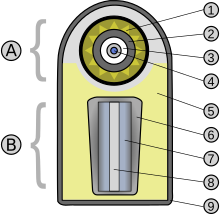
Back Termonukleêre wapen Afrikaans قنبلة هيدروجينية Arabic Arma termonuclear AST Hidrogen bombası Azerbaijani Тэрмаядзерная зброя Byelorussian Водородна бомба Bulgarian ဟုဲက်ဒရိုစိဉ်ဗွုံး BLK তাপ-পারমাণবিক অস্ত্র Bengali/Bangla མདེའུ་ཆིང་ཏན། Tibetan Vodikova bomba BS

Some designs use spherical secondaries.
- fission primary stage
- fusion secondary stage
- High-explosive lenses
- Uranium-238 ("tamper") lined with beryllium reflector
- Vacuum ("levitated core")
- Tritium "boost" gas (blue) within plutonium or uranium hollow core
- Radiation channel filled with polystyrene foam
- Uranium ("pusher/tamper")
- Lithium-6 deuteride (fusion fuel)
- Plutonium ("spark plug")
- Radiation case (confines thermal X-rays by reflection)
A thermonuclear weapon, fusion weapon or hydrogen bomb (H bomb) is a second-generation nuclear weapon design. Its greater sophistication affords it vastly greater destructive power than first-generation nuclear bombs, a more compact size, a lower mass, or a combination of these benefits. Characteristics of nuclear fusion reactions make possible the use of non-fissile depleted uranium as the weapon's main fuel, thus allowing more efficient use of scarce fissile material such as uranium-235 (235
U
) or plutonium-239 (239
Pu
). The first full-scale thermonuclear test (Ivy Mike) was carried out by the United States in 1952, and the concept has since been employed by most of the world's nuclear powers in the design of their weapons.[1]
Modern fusion weapons essentially consist of two main components: a nuclear fission primary stage (fueled by 235
U
or 239
Pu
) and a separate nuclear fusion secondary stage containing thermonuclear fuel: heavy isotopes of hydrogen (deuterium and tritium) as the pure element or in modern weapons lithium deuteride. For this reason, thermonuclear weapons are often colloquially called hydrogen bombs or H-bombs.[note 1]
A fusion explosion begins with the detonation of the fission primary stage. Its temperature soars past 100 million kelvin, causing it to glow intensely with thermal ("soft") X-rays. These X-rays flood the void (the "radiation channel" often filled with polystyrene foam) between the primary and secondary assemblies placed within an enclosure called a radiation case, which confines the X-ray energy and resists its outward pressure. The distance separating the two assemblies ensures that debris fragments from the fission primary (which move much more slowly than X-ray photons) cannot disassemble the secondary before the fusion explosion runs to completion.
The secondary fusion stage—consisting of outer pusher/tamper, fusion fuel filler and central plutonium spark plug—is imploded by the X-ray energy impinging on its pusher/ tamper. This compresses the entire secondary stage and drives up the density of the plutonium spark plug. The density of the plutonium fuel rises to such an extent that the spark plug is driven into a supercritical state, and it begins a nuclear fission chain reaction. The fission products of this chain reaction heat the highly compressed (and thus super dense) thermonuclear fuel surrounding the spark plug to around 300 million kelvin, igniting fusion reactions between fusion fuel nuclei. In modern weapons fueled by lithium deuteride, the fissioning plutonium spark plug also emits free neutrons that collide with lithium nuclei and supply the tritium component of the thermonuclear fuel.
The secondary's relatively massive tamper (which resists outward expansion as the explosion proceeds) also serves as a thermal barrier to keep the fusion fuel filler from becoming too hot, which would spoil the compression. If made of uranium, enriched uranium or plutonium, the tamper captures fast fusion neutrons and undergoes fission itself, increasing the overall explosive yield. Additionally, in most designs the radiation case is also constructed of a material that undergoes fission driven by fast thermonuclear neutrons. Such bombs are classified as two stage weapons. Fast fission of the tamper and radiation case is the main contribution to the total yield and is the dominant process that produces radioactive fission product fallout.[2][3]
Before Ivy Mike, Operation Greenhouse in 1951 was the first American nuclear test series to test principles that led to the development of thermonuclear weapons. Sufficient fission was achieved to boost the associated fusion device, and enough was learned to achieve a full-scale device within a year. The design of all modern thermonuclear weapons in the United States is known as the Teller–Ulam configuration for its two chief contributors, Edward Teller and Stanisław Ulam, who developed it in 1951[4] for the United States, with certain concepts developed with the contribution of physicist John von Neumann. Similar devices were developed by the Soviet Union, United Kingdom, France, China and India.[5] The thermonuclear Tsar Bomba was the most powerful bomb ever detonated.[6] As thermonuclear weapons represent the most efficient design for weapon energy yield in weapons with yields above 50 kilotons of TNT (210 TJ), virtually all the nuclear weapons of this size deployed by the five nuclear-weapon states under the Non-Proliferation Treaty today are thermonuclear weapons using the Teller–Ulam design.[7]
| Nuclear weapons |
|---|
 |
| Background |
| Nuclear-armed states |
|
- ^ Cite error: The named reference
NPR_TOTNwas invoked but never defined (see the help page). - ^ Gsponer, Andre (2005). Fourth Generation Nuclear Weapons: Military effectiveness and collateral effects. Independent Scientific Research Institute. arXiv:physics/0510071. ISRI-05-03.
- ^ Gsponer, Andre (2005). The B61-based "Robust Nuclear Earth Penetrator:" Clever retrofit or headway towards fourth-generation nuclear weapons?. Independent Scientific Research Institute. arXiv:physics/0510052. ISRI-03-08.
- ^ Cite error: The named reference
Tellerwas invoked but never defined (see the help page). - ^ Cite error: The named reference
:8was invoked but never defined (see the help page). - ^ Magazine, Smithsonian; Machemer, Theresa. "Russia Declassifies Video From 1961 of Largest Hydrogen Bomb Ever Detonated". Smithsonian Magazine.
- ^ Sublette, Carey (3 July 2007). "Nuclear Weapons FAQ Section 4.4.1.4 The Teller–Ulam Design". Nuclear Weapons FAQ. Retrieved 17 July 2011. "So far as is known all high yield nuclear weapons today (>50 kt or so) use this design."
Cite error: There are <ref group=note> tags on this page, but the references will not show without a {{reflist|group=note}} template (see the help page).